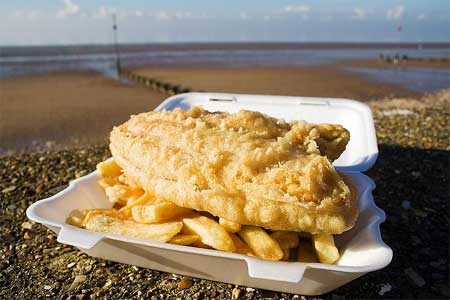 |
People in the U.S. have a love-hate relationship with fish and chips–Great Britain’s greatest contribution to American cuisine. The gripe for most people is that fish is generally healthy until it gets deep-fried and served with fried spuds and other high-fat, high-calorie sides. But properly done fish and chips are no doubt delicious, so it’s okay to indulge every once in a while. Right? And even a bigger gripe for some folks is that many U.S. restaurants in the new millennium are using whatever fish they can get their hands on (with some of them being less than honest about it), which usually equates to less recognizable species. Here are some things to think about next time you’re craving fish and chips.
1) It’s Healthy, Right?
As mentioned above, fish in general is healthier for you than beef and pork, but when it gets coated in beer batter and submerged in bubbling oil, along with a large portion of chips (think steak fries), and plated up with goopy cole slaw and mayonnaise-based tartar sauce, it can quickly become a gut-bomb with even more calories and fat than a messy bacon cheeseburger and fries. Of course, most people that eat healthy stay away from fish and chips, although, some do trick themselves by saying, “I’m just eating fish, man.”
2) In Cod We Trust
In most northern states, cod was usually what you got when you ordered fish and chips in the past. But because of declining numbers in many cod species, both in the Atlantic and Pacific oceans, restaurants are now forced (often by price alone) to serve less recognizable, cheaper species of fish. There’s no doubt that flaky, lightly battered cod fillets are delish, same goes for halibut (but who wants to pay $18 for fish and chips?), served with thick-cut fries and a splash of malt vinegar. Some mainstay places, like Ivar’s in Seattle, still highlight cod on the menu, yet, unfortunately, this could change in the future. But take solace in the words of the restaurant’s founder, Ivar Haglund: “Keep Clam.”
3) Pollock? The Abstract Painter?
Pollock is used for just about everything these days, from imitation crab to Japanese-style surimi (formed fish from fish pulp) to fish and chips. This grey-fleshed fish is an abundant cousin of cod that’s found in the northern Atlantic and Pacific oceans. Pollock has made its way onto many fast-food menus, including Long John Silver’s, which exclusively uses this mild-tasting fish for its standard fish and chips, and other places are following suit. Only problem here is that pollock doesn’t seem to hold up in the fryer as well as cod does so it can be oily and mushy. But some say that pollock actually has more flavor than cod. You be the judge.
4) What the Hake?
Depending upon where you are in the world, the fish that’s used in fish and chips varies greatly. Hake is another fish that often makes its way onto fish and chip menus, especially in the northern climes. This dense, white-fleshed fish is related to the cod family, although, many people turn their noses up at the very thought of hake. In Great Britain, haddock (offshore hake) and flounder are popular picks at fish and chip shops. Brits don’t mind a slightly stronger fish for their fish and chips, as opposed to Americans who don’t like their fish to taste like fish. The American restaurant chain Arthur Treacher’s specializes in English-style fish and chips, serving fried haddock, which is surprisingly mild tasting but it still has more flavor than pollock and cod.
We always want to be transparent and honest about our article content. From time to time, we may link to products and services that compensate us for the referral. This does not affect your cost, but it does help us fund future content for this site.
